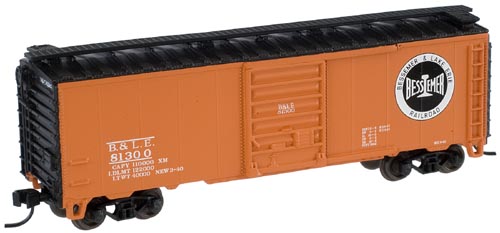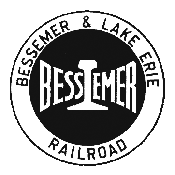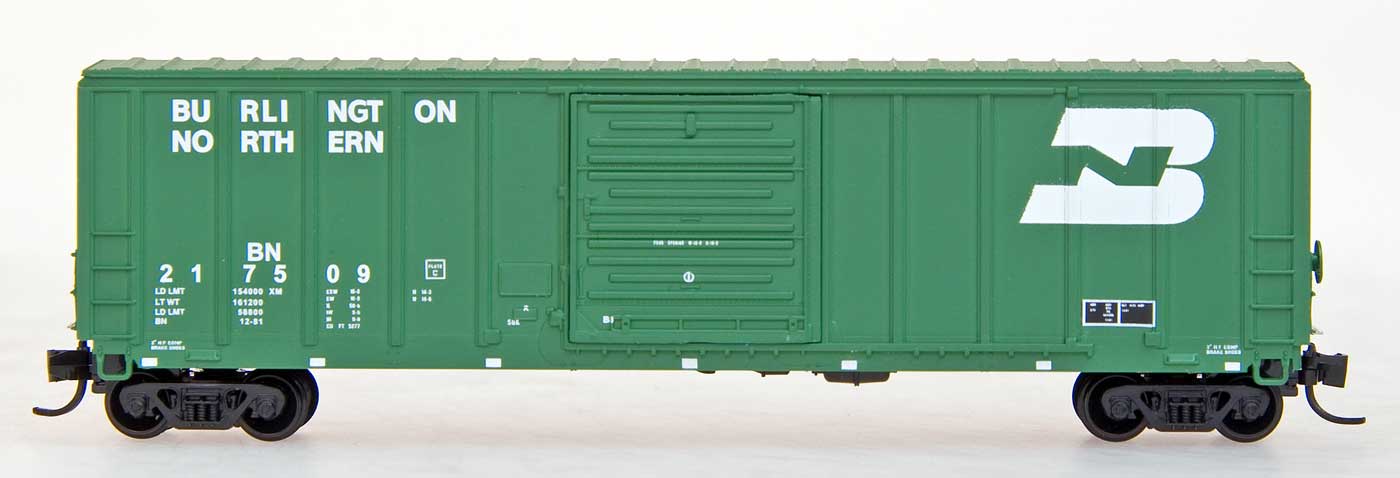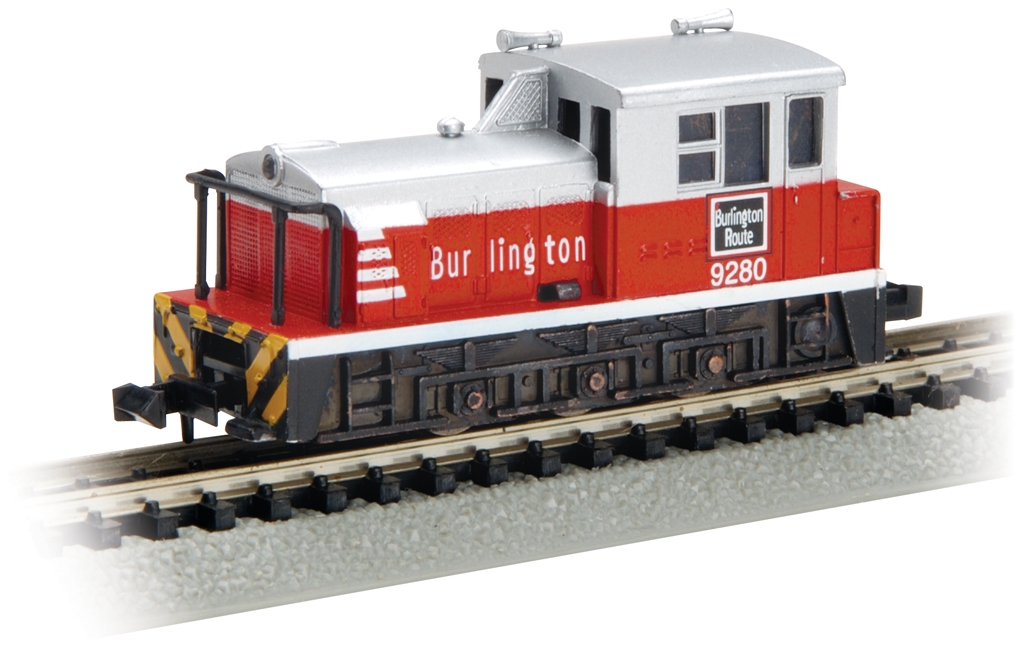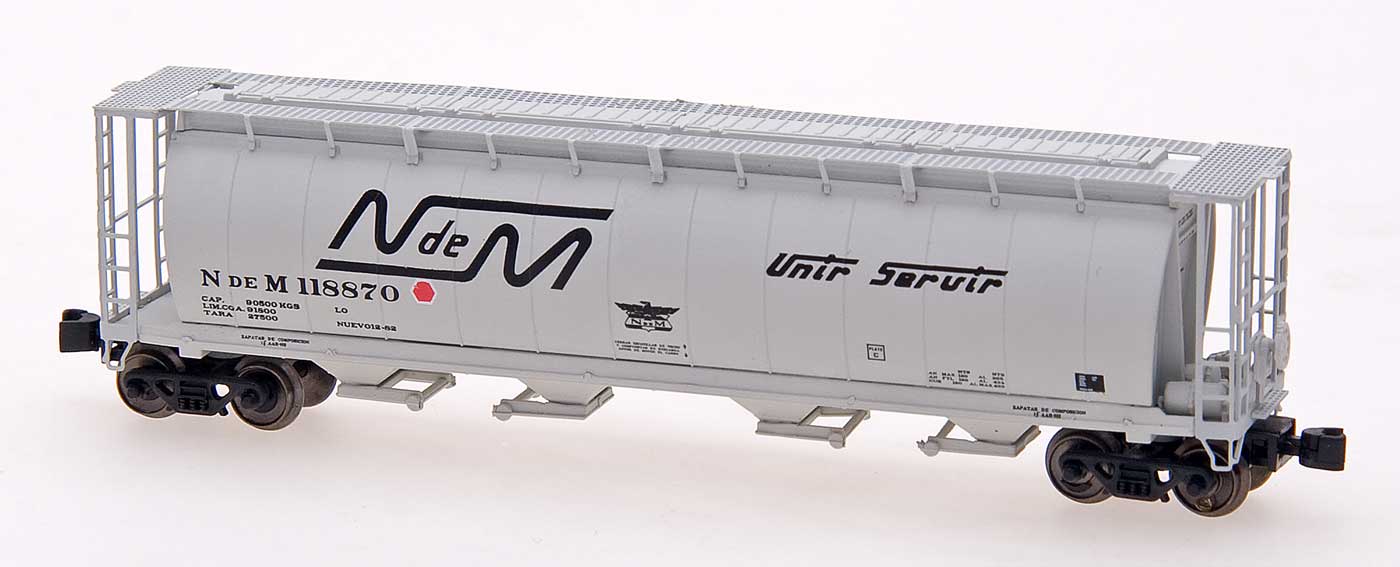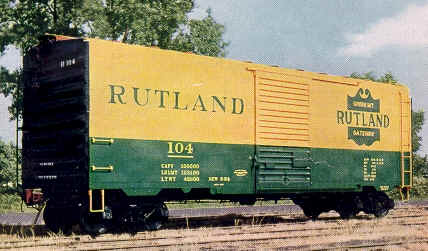Model Information: This tooling was introduced by Atlas in 1976. It replaced the earlier (and very similar) model from Roco of Austria that had been imported by Atlas from 1967 until 1975. Initial production was at the New Jersey factory. Production was later moved to China. As of 2017, this model is now very long in the tooth, so recent releases have been classified as 'Trainman' (budget) product line. Newer versions come equipped with Accumate couplers. This model should not be confused with the much newer 'Master' PS-1 boxcar from Atlas which is a completely different tooling.
Similar to other Atlas models of the 1970s and 1980s, this tooling originally featured Rapido Couplers and deep-flange nickel-silver plated wheels. When production moved to China, they started appearing with plastic low-profile wheels and Accumate couplers.
Sometime after 2005, Atlas created a 'Master' version of this model, and downgraded this tooling to the "Trainman" line. The new tooling was a complete redo of the model and has body mounted couplers, metallic wheels and excellent detailing, especially of the underframe. Since these are also marketed as 'PS-1' boxcars, it can be confusing. That tooling, however is different enough that we associate those cars with a different body style.
Similar to other Atlas models of the 1970s and 1980s, this tooling originally featured Rapido Couplers and deep-flange nickel-silver plated wheels. When production moved to China, they started appearing with plastic low-profile wheels and Accumate couplers.
Sometime after 2005, Atlas created a 'Master' version of this model, and downgraded this tooling to the "Trainman" line. The new tooling was a complete redo of the model and has body mounted couplers, metallic wheels and excellent detailing, especially of the underframe. Since these are also marketed as 'PS-1' boxcars, it can be confusing. That tooling, however is different enough that we associate those cars with a different body style.
Prototype History: The 40' Boxcar is widely known as one of the most popular freight cars used by railroads as they transitioned from steam to diesel. In particular the Pullman Standard or PS-1 design was one of the most popular and was widely used by North American railroads. These boxcars were built beginning in 1947 and share the same basic design, with certain elements such as door size, door style or roof type varying among the different railroads and production years. When production of these cars ceased in 1963, over 100,000 had been produced.
So just what is a PS-1? Well the simple answer is it is any boxcar built by Pullman Standard from 1947 on. The design changed over the years – sometimes subtly, sometimes for customer request, and sometimes in a larger way. In general, most PS-1’s built from 1947 to 1961 share the same dimensions and basic construction techniques. These cars all had a length of 40′, a height of 10’5″ or 10’6″, welded sides and ends and roof of Pullman’s own design. The greatest variation was in the size and style of doors used. Pullman Standard also offered 50′ and later 60′ boxcars – also with the PS-1 designation.
So just what is a PS-1? Well the simple answer is it is any boxcar built by Pullman Standard from 1947 on. The design changed over the years – sometimes subtly, sometimes for customer request, and sometimes in a larger way. In general, most PS-1’s built from 1947 to 1961 share the same dimensions and basic construction techniques. These cars all had a length of 40′, a height of 10’5″ or 10’6″, welded sides and ends and roof of Pullman’s own design. The greatest variation was in the size and style of doors used. Pullman Standard also offered 50′ and later 60′ boxcars – also with the PS-1 designation.
Road Name History: The Bessemer and Lake Erie Railroad (reporting mark BLE) is a class II railroad that operates in northwestern Pennsylvania and northeastern Ohio.
The railroad's main route runs from the Lake Erie port of Conneaut, Ohio to the Pittsburgh suburb of Penn Hills, Pennsylvania, a distance of 139 miles (224 km). The original rail ancestor of the B&LE, the Shenango and Allegheny Railroad, began operation in October 1869.
Rail operations were maintained continuously by various corporate descendants on the growing system that ultimately became the B&LE in 1900. In 2004 the B&LE came under the ownership of the Canadian National Railway as part of CN's larger purchase of holding company Great Lakes Transportation. As a subsidiary of CN the B&LE has been largely unchanged (though repainting of B&LE locomotives into CN paint with "BLE" sub-lettering began in April 2015) and still does business as the B&LE. Bessemer and Lake Erie's locomotives, especially the former Souther Pacific SD40T-3 "Tunnel Motors", have been scattered across the CN system lately; ironically, many are being used in the line that feeds most of B&LE's traffic, the former Duluth, Missabe, and Iron Range lines in Minnesota. The iron ore that originates on these lines is transloaded to ships at Twin Harbors, Minnesota, then sent by ship to Conneaut, Ohio, where it is again transloaded to B&LE trains. It is then taken down to steel mills in the Pittsburg area, mainly to the blast furnaces at US Steel's Edgar Thompson Plant in Braddock, Pennsylvania, part of the Mon Valley Works. As of summer 2015, most of the locomotives on the B&LE are former Illinois Central standard cab SD70's, although B&LE Tunnel Motor 905 and a few SD38's, still in B&LE orange, are being kept on the line. Also, a few Canadian National locomotives, especially SD60 5422, are assigned to the line.
The railroad's main route runs from the Lake Erie port of Conneaut, Ohio to the Pittsburgh suburb of Penn Hills, Pennsylvania, a distance of 139 miles (224 km). The original rail ancestor of the B&LE, the Shenango and Allegheny Railroad, began operation in October 1869.
Rail operations were maintained continuously by various corporate descendants on the growing system that ultimately became the B&LE in 1900. In 2004 the B&LE came under the ownership of the Canadian National Railway as part of CN's larger purchase of holding company Great Lakes Transportation. As a subsidiary of CN the B&LE has been largely unchanged (though repainting of B&LE locomotives into CN paint with "BLE" sub-lettering began in April 2015) and still does business as the B&LE. Bessemer and Lake Erie's locomotives, especially the former Souther Pacific SD40T-3 "Tunnel Motors", have been scattered across the CN system lately; ironically, many are being used in the line that feeds most of B&LE's traffic, the former Duluth, Missabe, and Iron Range lines in Minnesota. The iron ore that originates on these lines is transloaded to ships at Twin Harbors, Minnesota, then sent by ship to Conneaut, Ohio, where it is again transloaded to B&LE trains. It is then taken down to steel mills in the Pittsburg area, mainly to the blast furnaces at US Steel's Edgar Thompson Plant in Braddock, Pennsylvania, part of the Mon Valley Works. As of summer 2015, most of the locomotives on the B&LE are former Illinois Central standard cab SD70's, although B&LE Tunnel Motor 905 and a few SD38's, still in B&LE orange, are being kept on the line. Also, a few Canadian National locomotives, especially SD60 5422, are assigned to the line.
Brand/Importer Information: In 1924 Stephan Schaffan, Sr. founded the Atlas Tool Company in Newark, New Jersey. In 1933 his son, Stephan Schaffan, Jr., came to work for his father at the age of sixteen. Steve Jr. built model airplanes as a hobby and frequented a local hobby shop. Being an enterprising young man, he would often ask the owner if there was anything he could do to earn some extra spending money. Tired of listening to his requests, the hobby-store owner threw some model railroad track parts his way and said, "Here, see if you can improve on this".
In those days, railroad modelers had to assemble and build everything from scratch. Steve Jr. created a "switch kit" which sold so well, that the entire family worked on them in the basement at night, while doing business as usual in the machine shop during the day.
Subsequently, Steve Jr. engineered the stapling of rail to fiber track, along with inventing the first practical rail joiner and pre-assembled turnouts and flexible track. All of these products, and more, helped to popularize model railroading and assisted in the creation of a mass-market hobby. The budding entrepreneur quickly outgrew the limitations of a basement and small garage operation. Realizing they could actually make a living selling track and related products, Steve and his father had the first factory built in Hillside, New Jersey at 413 Florence Avenue in 1947. On September 30, 1949, the Atlas Tool Company was officially incorporated as a New Jersey company.
In 1985, Steve was honored posthumously for his inventions by the Model Railroad Industry Association and was inducted into the Model Railroad Industry Hall of Fame in Baltimore, Maryland. In addition, Steve was nominated and entered into the National Model Railroad Association Pioneers of Model Railroading in 1995.
In the early 1990s, the Atlas Tool Company changed its name to Atlas Model Railroad Company, Inc.
In those days, railroad modelers had to assemble and build everything from scratch. Steve Jr. created a "switch kit" which sold so well, that the entire family worked on them in the basement at night, while doing business as usual in the machine shop during the day.
Subsequently, Steve Jr. engineered the stapling of rail to fiber track, along with inventing the first practical rail joiner and pre-assembled turnouts and flexible track. All of these products, and more, helped to popularize model railroading and assisted in the creation of a mass-market hobby. The budding entrepreneur quickly outgrew the limitations of a basement and small garage operation. Realizing they could actually make a living selling track and related products, Steve and his father had the first factory built in Hillside, New Jersey at 413 Florence Avenue in 1947. On September 30, 1949, the Atlas Tool Company was officially incorporated as a New Jersey company.
In 1985, Steve was honored posthumously for his inventions by the Model Railroad Industry Association and was inducted into the Model Railroad Industry Hall of Fame in Baltimore, Maryland. In addition, Steve was nominated and entered into the National Model Railroad Association Pioneers of Model Railroading in 1995.
In the early 1990s, the Atlas Tool Company changed its name to Atlas Model Railroad Company, Inc.
Item created by: gdm on 2017-08-24 18:11:58. Last edited by gdm on 2020-06-05 11:47:58
If you see errors or missing data in this entry, please feel free to log in and edit it. Anyone with a Gmail account can log in instantly.
If you see errors or missing data in this entry, please feel free to log in and edit it. Anyone with a Gmail account can log in instantly.


